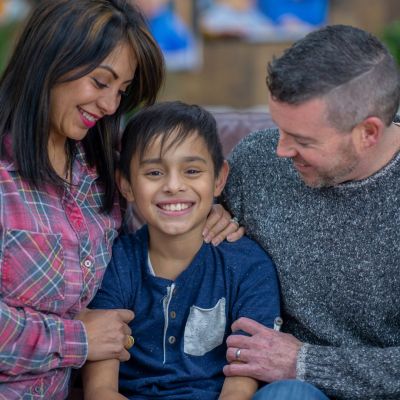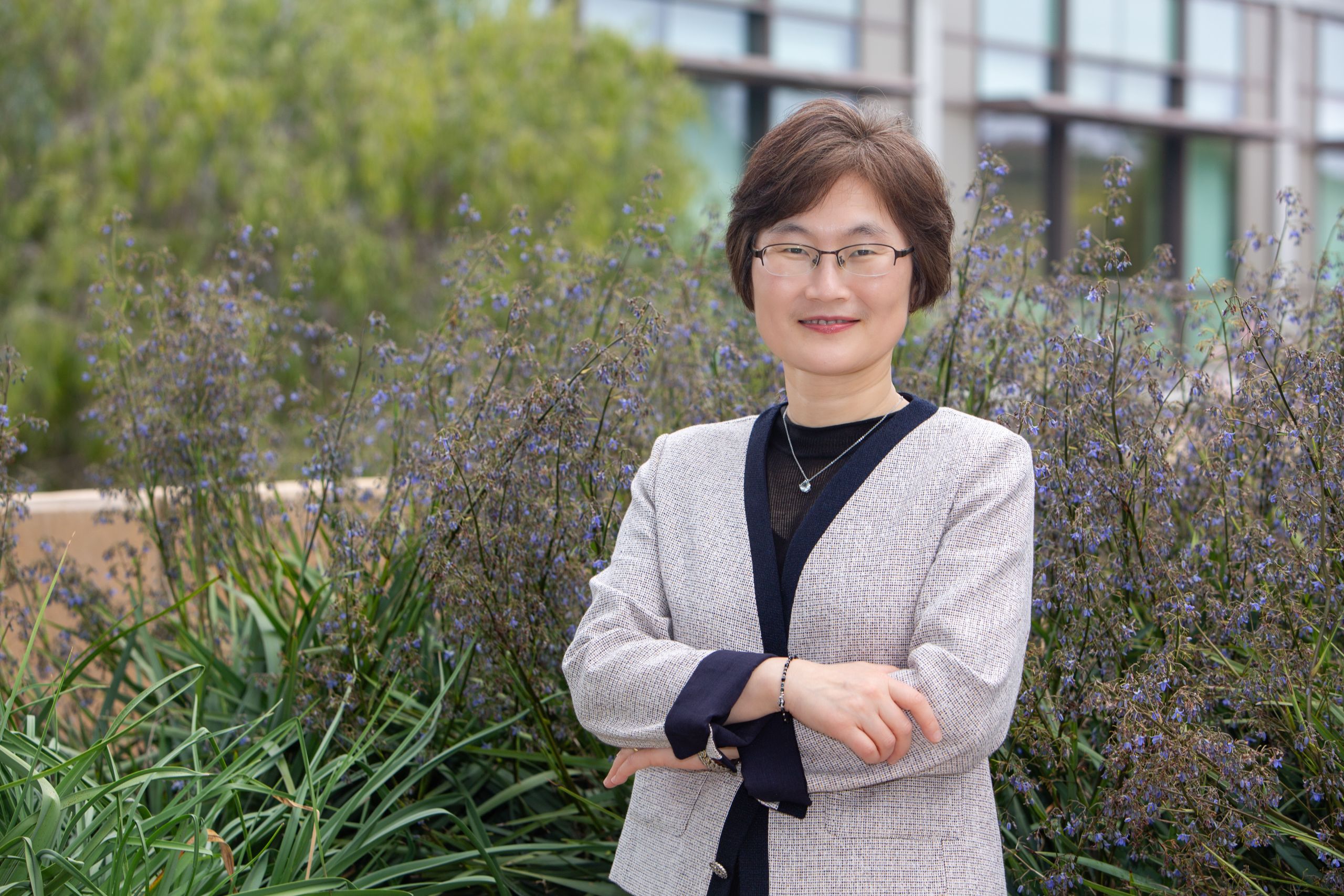 “Pain really is a complex phenomenon,” reflects Associate Professor Michelle Fortier. “It’s multi-dimensional. There are so many pieces to it. I could spend thirty careers on pain: there is so much to do here.”
“Pain really is a complex phenomenon,” reflects Associate Professor Michelle Fortier. “It’s multi-dimensional. There are so many pieces to it. I could spend thirty careers on pain: there is so much to do here.”
Fortier is a clinical psychologist and pediatric pain expert at the UCI Sue & Bill Gross School of Nursing and UCI Center on Stress and Health. Although children’s pain is her specialty, the conceptual focus of her research is necessarily broader.
“For me, all my work comes under the umbrella of improving quality of life,” she says. “It’s in the realm of symptom science, which is a nursing area and a growing part of our school. How do we better develop more tailored approaches to symptom management? We know it’s not ‘one size fits all.’ There’s so much context that impacts the experience of pain, and how we handle it.”
Pain differences between cultures
Importantly for health equity, a significant aspect of the context to which Fortier refers is cultural. There are distinct differences in the way pain — including pediatric pain — is felt, understood and managed in different communities. Working with families that were tasked with the postoperative care of children at home, it was clear to Fortier and her team that advice from the hospital was not always being interpreted as intended.
In a study of children recovering post-tonsillectomy, for example, “We saw that Spanish-speaking children had poorly managed pain, were not given analgesics by parents… there were misunderstandings. We needed to understand what drives these disparities. And I wanted to translate these findings to oncology pain.”
“Partnering with the community is a consistent thread throughout my research,” she continues. “For that to be effective, you have to ask yourself, ‘Are we asking questions that are relevant to the community?’ When we work with our Spanish-speaking community, I learned that I was asking the wrong questions.”
Empowering Spanish-speaking families
Fortier is referring to her most recent work: Corazones Unidos Por Una Vida (Hearts United for Life), a prototype program of support for Latinx families with children who are undergoing cancer treatment at UCI. Alex’s Lemonade Stand Foundation for Childhood Cancer provided funding that enabled Fortier, her team and their community partners — the Corazones (Hearts), as the Spanish-speaking families involved have come to be called — to develop a 12-session intervention and associated materials.
Due to COVID, planned in-person sessions had to take place over Zoom, which Fortier feared wouldn’t work at all but luckily, “worked beautifully.”
“I came in thinking it was going to be pain-focused,” says Fortier, “but it’s a family well-being intervention. It’s about health literacy: empowering them to get the information they need in culturally appropriate ways.”
These ways included exchanging information in group settings rather than one-to-one; involving whole families and professionals in designated “question and answer” sessions; and developing a “beautiful brochure” that consolidates and clarifies (in Spanish) the overwhelming quantity of information traditionally presented to the families of children diagnosed with cancer — the “big binder” that more usually, says Fortier, “…goes home with them and gathers dust. They don’t even open it.”
‘It’s so important to them to give’
Thirteen families have taken part in the intervention so far, with six still to come — but already, the results are inspiring. Participants are completely committed to helping and supporting new families coming in post diagnosis. This has included – in one case — a mother who sadly lost her child during treatment. “I thought for sure she would not continue her work with us, but she did. Their motivation and dedication to this work is incredible — they said, ‘We can see that this is important and we want to do it.’ It’s so important to them to give.”
“Quite honestly, it’s the most meaningful work I think I’ve ever done,” Fortier states. “Almost every day we get some piece of feedback from the hospital or the families that shows us how this is making a difference.”
An early focus on helping children
Even as an undergraduate in psychology at University of California, Riverside, Fortier knew that she wanted her work to focus on children. “They have so much potential and resilience,” she points out.
After gaining her MA at San Diego State University, she completed clinical training among widely differing populations in West Virginia, rural Nebraska and, finally, as a postdoctoral fellow at the Mayo Clinic in Minneapolis. It was here, at the clinic’s dedicated pain center, that she found her specialism: “Patients would come in completely not functioning, not socializing, spending their days in bed. With a team approach to pain rehab, we saw people come alive. It was very rewarding. I really wanted to be in the field of pain.”
The long-term impact on patients, however, mattered as much to Fortier as these immediate, palpable results.
Consequences of poor pain management
“Poorly managed pain in children can have a cascade of negative lifelong effects,” she explains.
“It leads to the increased likelihood of poor pain experiences for that person in the future. They get very distressed at the prospect of pain and may try to avoid healthcare. Adults who have had experience of poorly managed pain during childhood report avoiding routine healthcare visits, immunization, health checks… there’s a whole host of effects that lead to reduced quality of life.”
When Fortier completed her fellowship at the Mayo Clinic, she had the opportunity to return to California to work with post-operative pediatric patients at UCI/CHOC Children’s Hospital. Once there, she was quick to identify the ways in which she would be able to augment the area’s existing provision. “
We don’t have a pain center for kids in Orange County, but we do have a cancer center and those patients experience recurrent pain throughout treatment. So I thought, ‘Here’s an opportunity to take what I know and have a profound impact on a population.’”
It was also when working on surgery-related pain that Fortier was first led to consider the management of children’s pain in the home. Recovering at home is generally “great for quality of life,” she says, “but suddenly we shifted all this pain management responsibility onto parents, but we didn’t do anything to help them with it. Parents were undertreating pain at home. People don’t understand that the emphasis is on pain prevention, not pain treatment. We can do a lot to prevent pain but if you don’t prevent it, you’re chasing it and it’s really difficult to manage.”f
Managing pain through technology
One of Fortier’s successful initiatives is the Pain Buddy app, a mobile intervention designed to help child and adolescent outpatients to describe and report their pain direct to hospital staff on a regular basis, without waiting for their next appointment or — crucially for many children — increasing their own parents’ anxiety and distress.
The app has been developed as an integrative health initiative with input from nurses about pain thresholds for intervention, as well as with patients and other practitioners working together on means to describe the various kinds of pain and their intensity. In addition, the app supports learned pain management techniques such as mindfulness, visualization and muscle relaxation. As with all Fortier’s work, nurses are key.
“It’s nurses that respond to the symptom alerts that we get from kids. Of course, oncologists ask their patients about pain, but nurses are the providers who really have a day-to-day interaction with the children and their families,” she points out.
“There’s opportunity to expand that even more — to integrate more of what we do into the field of nursing.”
Educating students on the science of pain
In addition to her research work, Fortier created and teaches the school’s graduate and undergraduate courses on pain science. Given how central fear of pain is to many people’s attitudes to their health — prevention, care, recovery and rehabilitation — those outside the profession might be surprised by how little education healthcare providers generally receive about assessing and managing pain.
Fortier’s courses are elective, but are appropriate for all health professionals: nurses, doctors, pharmacists and public health experts.
Next: culturally appropriate palliative care
Building on her work with the Corazones, Fortier is now determined to research how to broaden uptake of all palliative care services. Pending funding, she plans to develop, “a culturally appropriate palliative care model for families affected by childhood cancer. There’s a taboo in the general population that affects uptake of palliative services — more so in the Spanish-speaking community.
“The American Academy of Pediatrics had done a survey and showed that children were not accessing palliative care services at the same rate that adults were, and they put in a lot of effort to improve that. This led to more children accessing palliative care – except in the Latinx community. We had to understand what we can do to address that.”
As ever, Fortier is determined that the best possible quality of life should be available to all children, from every community and at every stage of their treatment.
“We need to shift the way we think and talk about palliative care,” she declares. “There are widespread misunderstandings about palliative care – it’s not just end of life. That’s not been my focus at all.”




Great Post! Understanding these cultural differences is crucial in healthcare settings to ensure that patients receive appropriate and effective pain management tailored to their cultural beliefs and preferences. Healthcare providers need to be culturally competent, recognizing and respecting these differences to provide optimal care for patients from diverse cultural backgrounds. Additionally, research and medical education should be sensitive to these cultural factors to improve the overall quality of pain management across different cultures.